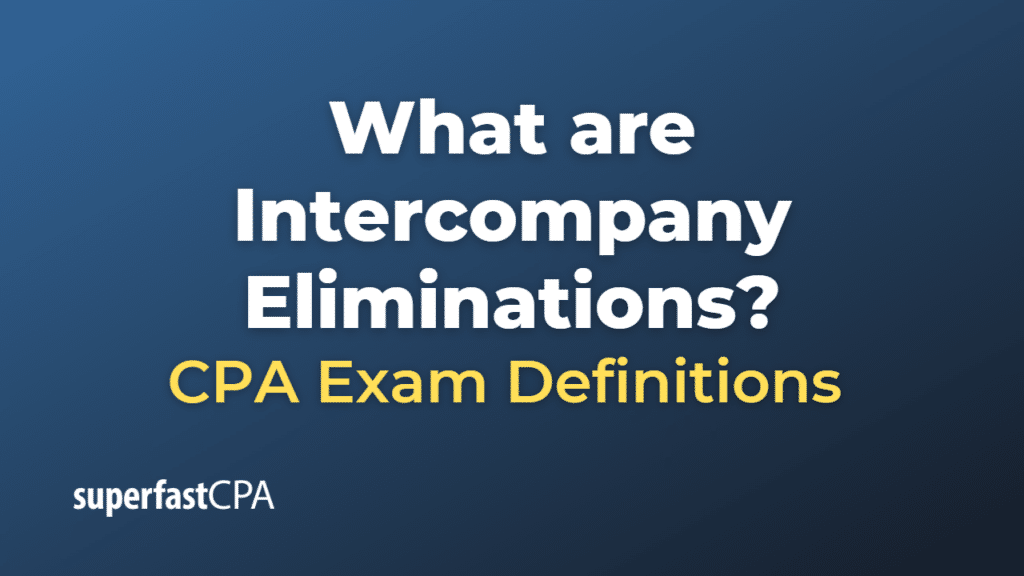Intercompany Eliminations
Intercompany eliminations are adjustments made in the preparation of consolidated financial statements to remove the impact of transactions that occurred between the parent company and its subsidiaries or between the subsidiaries themselves. The purpose of these eliminations is to present a financial report that accurately represents the financial status and performance of the entire group of companies as a single economic entity.
Here are a few examples of transactions that may require intercompany eliminations:
- Intercompany Sales and Purchases: If one subsidiary sells goods or services to another subsidiary, that transaction is recorded as revenue by the selling entity and as an expense by the purchasing entity. However, from a consolidated perspective, the group has not made a sale to an external party or incurred an expense. Therefore, these intercompany sales and purchases are eliminated during consolidation.
- intercompany loans: If one entity in the group lends money to another, this creates an intercompany loan with a corresponding intercompany receivable and payable. When preparing consolidated financial statements, these balances must be eliminated against each other.
- Intercompany Dividends: If one entity in the group pays dividends to another, these dividend payments and receipts are eliminated in the consolidated financial statements.
- Intercompany Profits: Profits from intercompany transactions that are included in the carrying amount of assets, such as inventory or fixed assets, need to be eliminated. For example, if one subsidiary sells inventory to another at a profit, but the inventory is still unsold to outside entities at the end of the reporting period, the profit on the intercompany sale is eliminated in consolidation.
Intercompany eliminations are critical in ensuring that the consolidated financial statements only reflect transactions with external parties and provide a clear and accurate picture of the financial health and performance of the entire group. They prevent double-counting of revenue, expenses, assets, and liabilities, and ensure the financial statements comply with accounting principles and standards.
Example of Intercompany Eliminations
Let’s consider an example involving a parent company, ParentCo, and its two subsidiaries, Subsidiary1 and Subsidiary2.
- Intercompany Sales and Purchases: Subsidiary1 sells $500,000 worth of goods to Subsidiary2. In Subsidiary1’s books, this is recorded as revenue. In Subsidiary2’s books, this is recorded as an expense and added to inventory. However, for the consolidated ParentCo accounts, this is an internal transaction and must be eliminated to avoid inflating revenue and inventory. So, in the consolidated financial statements, we would reduce (eliminate) both revenue and inventory by $500,000.
- Intercompany Loans: Subsidiary1 loans $200,000 to Subsidiary2. Subsidiary1 records this as a receivable, and Subsidiary2 records this as a payable. In the consolidated accounts of ParentCo, these would offset each other, as it’s essentially money the company owes to itself. Therefore, both the intercompany receivable and payable of $200,000 would be eliminated.
- Intercompany Dividends: Subsidiary1 pays a dividend of $50,000 to ParentCo. This would be recorded as dividend income by ParentCo and as a reduction in equity by Subsidiary1. In the consolidated financial statements of ParentCo, these transactions offset each other and are eliminated, because they are internal cash flows that don’t affect the overall group’s equity.
- Intercompany Profits: If Subsidiary1 sells inventory to Subsidiary2 with a profit of $100,000 and Subsidiary2 still has this inventory on hand at the end of the year, this intercompany profit needs to be eliminated in the consolidated accounts. The reason for this is that this profit is not realized until the inventory is sold to an outside party. Thus, we would reduce (eliminate) both inventory and retained earnings by $100,000 in the consolidated statements.
These examples demonstrate how intercompany eliminations work to ensure that the consolidated financial statements accurately reflect the economic activities of the overall corporate entity, excluding internal transactions.













